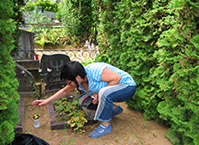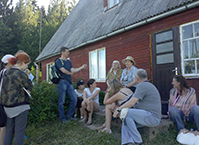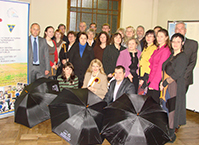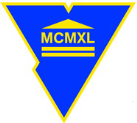The bread's baking traditions
Categories: Dagnija Bramane
In your family you bake bread yourselves, don’t you?
Yes, we still preserve this tradition of the olden times and we do bake bread at home. The holder of the tradition is my grandmother, who taught to bake bread to both my mother and me. Bread baking, in the same vein as beer making, is a process, and every person performs it in a slightly different way. Our way of making bread maybe slightly differs from that old times’ tradition. We bake both rye bread, and sweet-and-sour bread and white bread. The recipe says that at first it is necessary to make dough. To make dough – it means to boil potatoes, we add potatoes to bread; yes, we do. To boil potatoes, mash them as if making mashed potatoes, to mash them in that kneading trough, I think it is said – in a tub, add caraway seeds, salt and sugar, pour boiling water over and mix, and then add a little rye-flour – some 4 or 5 glasses, depending on how much bread you want to make. Then boiling water should be poured over the whole mass and mixed into rather liquid mass, and it is left for twenty-four hours. Not for twenty-four hours, but until the next morning – until nine or ten a.m., if it has been made in the morning, too. Well, actually it turns out to be almost twenty-four hours. We leave the dough for the night in some warm place; tuck it up with pillows, fur-coats, whatever you have at home, so that bread is warm. Then the next morning we take all those blankets off and see what has happened during the night. The bread has been maturing and the next day we add bakers’ yeast to it; we mix it with warm water, add bakers’ yeast bought in a shop, which was not available earlier, but now it is. And we add more flour depending on what bread we want to bake. If we want rye bread, we add rye-flour; if we want sweet-and-sour bread, then we add a little of wheat flour. Thus we add flour, mix bread, add more sugar when tasting how sour or sweet it is. We knead it rather hard, hard, it is very very thick. It should be kneaded for rather long time. It is rather hard work. My granny always said that there used to be such a saying: you should knead bread until you forehead is wet with sweat. When the bread is kneaded, it is again left for some half an hour, an hour or two; and at the same time, the bread oven is heated. When the oven is ready, we usually put two or three armfuls of wood in the bread oven, then we take out coals and ashes and then we already make big loafs in the kitchen, put them on the bread-shovel and place them into the oven. There is a tradition that bread is placed on maple leaves, sweet flags or some other things of the kind, but we don’t do that. However, one can do it. Then bread is baked for two hours, and, when we see that the loafs are nicely brown and the whole room smells of bread, then we know that the bread is ready. In addition, in order to use that the oven is being heated, we bake also white bread, sometimes we bake pies, or apples, etc. Then in the evening, it is great delight when there is warm bread with homemade butter and milk; and it is such an event.
Audio
Researcher: Dr. philol. Valentīns Lukaševičs, Daugavpils Universitāte










